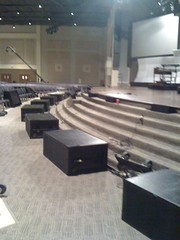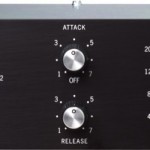Tight Lows
Achieving a tight low-end is sort of the Holy Grail of mixing bass, and it’s something I chased for a long time without understanding what was really involved in getting it. There are a lot of mixing articles on the web about achieving a tight low end, but a big component that is often overlooked in tight low end is the amount of low-end sustain we’re dealing with in the first place. Achieving a tight low-end requires the ability to control the attack and sustain at low frequencies.
The biggest challenge I run into with this in live sound usually stems from the acoustics of the room. The reality is a large number of performance venues–and especially larger venues–have extended reverb times at low frequencies. In these rooms the acoustics of the room often have tilted reverb times where the room reverb in higher frequencies is shorter relative to lower frequencies. When our room adds reverb to our low end, it has a tendency to smear the low end which is the enemy of tight low end. This doesn’t mean we’re completely out of luck, but it does put a limit on how tight the low end can really be.
The next factor in controlling sustain is our subs. I learned from the great folks over at d&b a few years ago that they use extremely strong magnets in their subs because it helps them stop faster, and this allows for better transient response. d&b isn’t the only manufacturer making great subs, and I’m not suggesting you start putting in budget requests to swap out your subs, either. However, you need to keep in mind that this is another factor that will limit how tight you can get your low end in the room.
A third factor that trumps everything is, of course, your instruments and the players on stage. If our drummers and bass players aren’t locking together, the low end isn’t going to be tight. The instruments also need to be setup and tuned properly. A kick drum that resonates too long will not sound tight and punchy. This is part of why a lot of drummers put pillows or some other form of muffling in their kick drum. It’s also another reason why some bass players use some sort of a mute on their strings in the studio. For example, classic bass players like James Jamerson and Carol Kaye both used foam or felt mutes under their strings to control sustain. Our tight low end will only be as tight as the instruments allow.
So what can we do as engineers to control sustain?
We have a couple of ways of manipulating it through the use of our dynamics processors. First up would be a compressor. Compressors often increase sustain especially on something like a bass, but we can also use them to decrease the sustain a bit. This can be done by adjusting the attack of the compressor to emphasize the front-end transient of a sound. For example, if we slow the Attack on a kick drum to let the initial hit come through, the compressor will attenuate the sustain of the sound if we adjust and slow the Release to hold that attenuation down.
Another method that is often more effective is to use a Gate/Expander. By adjusting our Gate’s Release longer or shorter, we can effectively increase or decrease the sustain of the instrument. It’s not unusual for me to use a fairly short release on a kick drum in a highly reverberant space. You just need to be careful when you’re playing with sustain in the room because what works for the room might not work for say, a drummer’s in-ears.
One other method would be to use a Transient processor. I’m thinking of things along the lines of the SPL Transient Designer or Waves Smack Attack plug-in. These types of processors usually have a “Sustain” control which may be adjusted to increase or decrease the amount of sustain without the adverse effects compression and gating may sometimes introduce.
Aside from dynamics processing, something else we can do to help tighten up our low end is to make sure we clean up non-musical junk in the extreme lows. This could be from things like mic handling noise, vibrations through mic stands and the floor, and sometimes even the instruments themselves. I handle this with variable high-pass filters on inputs, and I’m not afraid to use them on things like bass guitars or kick drums, either. The key to adjusting these is you have to listen. I’ll slide the filter up until I start hearing good stuff disappear, and then I’ll lower the frequency a bit to get back to a natural sound. A 4 string bass has a low E fundamental around 40 Hz so the stuff below that isn’t typically going to be music. The same can be said for a kick drum with a fundamental around 50 Hz. Sometimes there is nice stuff below that, though, so be careful but don’t be afraid to try it.
Now, maybe a bigger question is how do you hear what’s really going on with your low end so you can really dial it in when you’re in a highly reverberant space? This is especially important if you’re doing streaming because the last thing you want is to set dynamics processing so it adversely affects those environments outside your room. My first suggestion would be to get some kind of virtual soundcheck setup going because it will be much easier to experiment when you’re not waiting on a band and a band isn’t waiting on your. Then you have a couple of options.
Option 1 would be to get a nice set of nearfields at FOH, and Option 2 would be to get a nice set of headphones. Now turn off your PA and start mixing on one of those options. A quality set of headphones with balanced frequency response and good low frequency extension will give you a very controlled listening experience to hear what’s going on with your low end, but I personally prefer using speakers for extended mixing time.
A final thing you should do is learn what your room and PA is capable of doing. A good way to go about this is to get some reference tracks with tight low end and start playing them in your PA. Listen to them over and over and over again to get familiar with what the room will do. Just keep in mind that a lot of rooms tighten up when they fill up with people, but if you get familiar with what it should be when it’s empty you can get things right in the pocket for when people fill it up.
What are your favorite techniques for getting tight low end? I’d love to hear about them in the comments.


 Previous Post
Previous Post Next Post
Next Post



What are your reference tracks that you like to use that have a get low responce?
There are a couple of different things I’ll listen for when I’m on a new PA in terms of low end response. First there’s just kind of quantity and “fullness”. For that I’ll use something like “I Will Remember” by Toto, and I also use that to judge the overall frequency response of a system because I have heard it 1000’s of times at this point. When I’m checking more of the “punch”, I’ll throw on “Everybody Here Wants You” by Jeff Buckley. I use that one because it’s punchy but not super-punchy, and on a really good, tight system it will hit me in the chest.
for me the most modern album I love to play when referencing a system is The Rebirth Of Kirk Franklin that album hit’s on so many levels. I haven’t heard a recent album mixed like that in a long time. Whom ever mixed that album put there foot on it and to have herb powers master it that’s my goto. I will def check for your reference and add it to my group.
I spend a lot of time during soundcheck on making the kick and bass work together. Often, I will make a small cut at the primary bass drum frequency on the base, and give the base guitar it’s own small boost right above/below, depending on the genre/tuning. These boosts can be quite narrow.
If the room has a lot of reverberation, I will gate the kick and toms. Depending on the desk I use a frequency-sensitive gate to optimise it and really shape the sustain, together with the compressor.
If needed I will lowcut some other instruments – sometimes more than I like to, to ensure that kick & bass are coming through.
Finally, I will tame the bass frequencies with a multiband compressor to make them more compact and/or tame big transients that would cause too much reverberation.